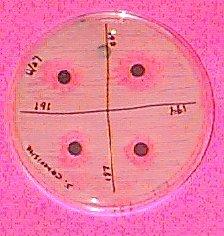24 December, 1996
It's Christmas Eve, although it wasn't traditional, it was an exciting day
for me. Since Bill and Gamini left three weeks ago, I seem to have gotten
bogged down. I've had trouble isolating a compound for an experiment I
wanted to complete before leaving. In addition to the lab work, samples of
algae mats from different locations around the Sound need to be collected.
That has always been enjoyable even though it's physically demanding.
Typically it means hiking in rough terrain with a pack that's heavier than I
like to carry. Each sample also needs to have chemicals extracted,
concentrated, and assayed.
The assay are to determine if the extract will inhibit the growth of
specific species of bacteria or fungus. After processing samples for about a
week, I've found one that has anti-fungal properties. Two night ago, I got
my first hint that the extract inhibited the growth of a parcticular fungus.
I wanted to be certain that the experiment was done correctly so I repeated
it again last night. When I checked the incubator, the results were the
same, no fungal growth. Now I need to try to isolate the compound in the
extract that was responsible.
The process will be to take the extract and separate it into chemically
unique factions. Each fraction will be again assayed. Hopefully, one will
still be active. The active fraction will be separated again and the process
repeated until the activity remains with a fraction that contains a single
compound.
I've included pictures of two microbial assays. Each Petri dish contains a
nutrient that supports the growth of the specific microbe being used in the
assay. The small circles arranged in the Petri dishes are paper disks which
have been saturated with two milligrams of extract. Before the disks were
added, the dish was smeared with fungus. In the dish on the left, the fungus
grew over the disks and the pink background can not be seen. We can conclude
that those compounds do not inhibit the growth of the microbe on the dish.
On the right, the pink background can be seen around the disks. Those are
regions where the fungus did not grow. The extract on those disks contains
compounds that we would like to identify.


The first assay shows negative results, the zones of inhibition in the second photo indicate the extract is microbially active.
Contact the TEA in the field at
.
If you cannot connect through your browser, copy the
TEA's e-mail address in the "To:" line of
your favorite e-mail package.
|
